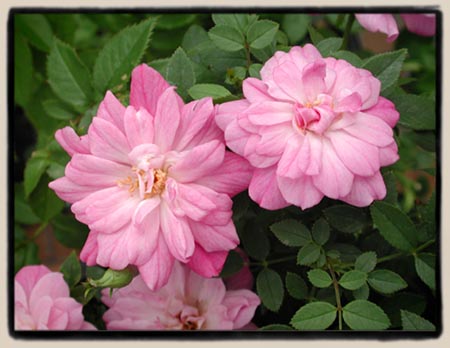 |
|
Albas |
'Rouletii', a found rose, Switzerland, circa 1922
"A few years ago a friend of mine, Dr. Roulet, found in a little village near Grandson, a very minute Rose grown in pots in the windows. It was a minuscule shrub, five centimetres high, bushy, and covered with small Roses not exceeding one and a half centimetres broad (just like a sixpenny piece). He told me about the plants and I went to see them; but just at that time the whole village of Mauborget had been burned, so we could not find a single plant. Local people stated that a woman in another village, Onnens, five miles away, had a similar plant. So we went there and my friend obtained a little growth of the Rose, which he gave me. We increased it, and soon had hundreds of plants which I named Rosa Roulettii, after my friend. This is the most liliputian of all Roses, but where these good people got it from nobody can say. "It has been grown here for centuries, but only in windows and never out in the garden, as it is too delicate a plant,"-so say the peasants. After studying the subject I found in de Candolle's Prodromus. Vol. 2, p. 600, that there was in the beginning of the nineteenth century a form of Rosa indica II called humilis by Seringe and pumila by Redoute, which is said to be minutis. But mine is minutissima. "In her classical Rose book, Miss Willmott mentions a Rose chinensis var. minima, Rehder (The Fairy Rose), but she means the Lawrance Rose we grow at Floraire, which is not the same as my plant. Who can tell me anything about it? The village of Mauborget, where this tiny Rosa has grown "for centuries," is not far from Champagne, above Grandson, where de Candolle had his garden. Did M. de Candolle grow the plant in his house, and has it been thus distributed in the neighborhood? I could not find any trace of this Rose elsewhere in the country, and nobody, not even old people, could give me any further explanations. They all seem to believe that the minute Rose is an old kind grown from a time immemorial in Mauborget. Of course, it is better for pot culture in windows than in the open ground. We planted some in a bed in order to get material for cuttings, and there it lost something of its character of a dwarf compressed shrub, and grew higher (ten centimetres high). But the flowers and the leaves are never larger than in the case of window plants, and it remains the smallest of all shrubs. It flowers perpetually, and I have just been out to gather little buds from under the snow covering my garden at Floraire, which I send you herewith. Henry Correvon, Geneva" This account is the closest we have to anything that documents the origin of R. rouletii, and it must be taken with a grain of salt when it is suggested that it grew in these villages "for centuries". Many Rosarians have put forth the suggestion (Ralph Moore) that R. rouletii was more likely a seed grown plant (or plants, for that matter) that originated from Chinese hybrids which was kept for its portability, allowing for its survival in Swiss winters. I tend to agree with this hypothesis. Whatever its origin, this is still a rose well worth growing for its unique charm, not to mention its historical value. ARS
merit rating: 7.7 Click on the names below to view the individual varieties. Original photographs and site content © Paul Barden 2006, All Rights Reserved. |
|

 The
original letter from Henry Correvon, regarding his discovery of R.
rouletti in Switzerland:
The
original letter from Henry Correvon, regarding his discovery of R.
rouletti in Switzerland: